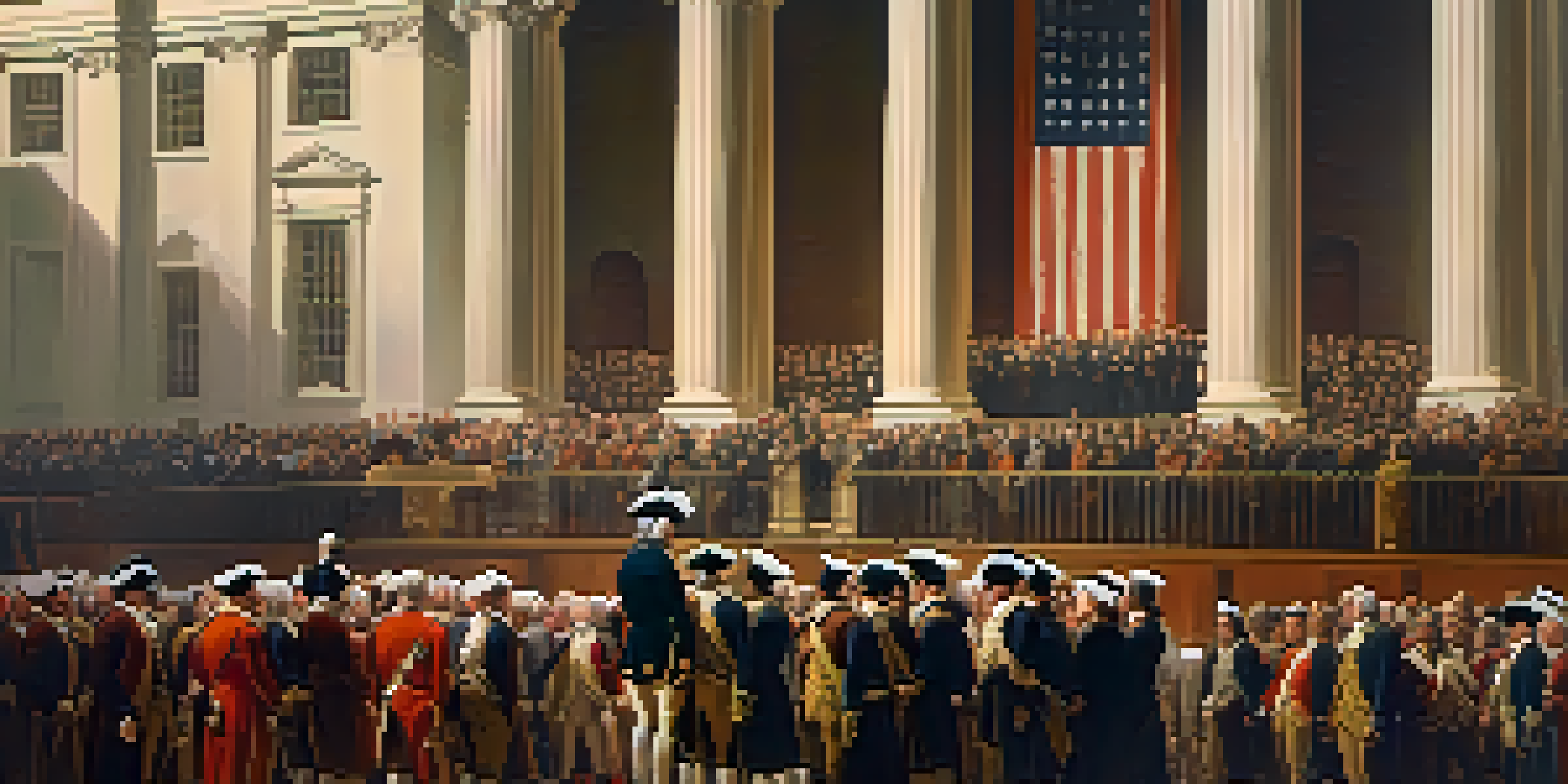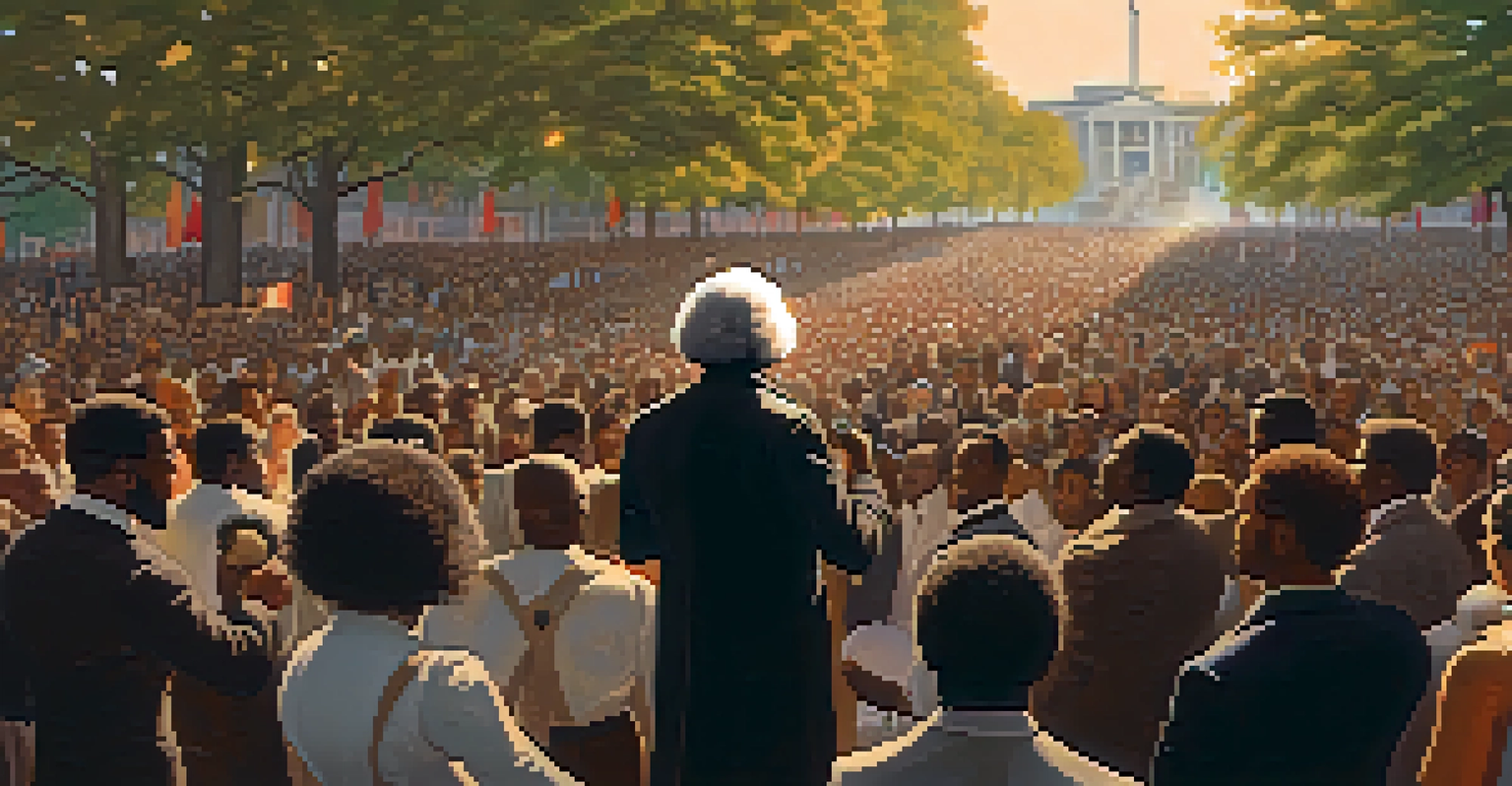Influential Figures in New York State's Historical Journey

George Washington: The First President's New York Connection
George Washington, often referred to as the father of our nation, had a significant connection to New York State. In fact, he was inaugurated as the first President of the United States in 1789 at Federal Hall in Manhattan. This moment marked a pivotal transition for the country, as New York was the first capital under the new Constitution.
The future belongs to those who prepare for it today.
Washington's leadership not only helped establish the presidency but also fostered a sense of unity among the states. His choices and policies laid the groundwork for future leaders, and his presence in New York symbolized the city's emerging prominence in American politics. He frequently visited the city, forging relationships with influential figures of his time.
His legacy in New York is commemorated through various monuments and sites, serving as a reminder of his role in shaping both the state and the nation. Washington's influence remains a cornerstone of New York's historical narrative, illustrating the connection between leadership and location.
Alexander Hamilton: The Architect of American Finance
Alexander Hamilton, one of the Founding Fathers, played a crucial role in establishing the financial foundation of the United States. Born in the Caribbean but rising to prominence in New York, Hamilton served as the first Secretary of the Treasury. His visionary policies, including the creation of the national bank, transformed the American economy.

Hamilton's influence extended beyond just finance; he was also a key figure in drafting the Federalist Papers, which argued for the ratification of the Constitution. His debates with Thomas Jefferson highlighted the early ideological divides that would shape the political landscape of America. New York City served as the backdrop for many of these crucial discussions.
Washington's New York Inauguration
George Washington's inauguration as the first President in New York marked a crucial moment in American history and the city's political ascent.
Today, Hamilton's legacy is celebrated through various monuments, including the Hamilton Grange National Memorial in Harlem. His story resonates as a testament to ambition and the impact one individual can have on a nation's direction, making him a central figure in New York's historical journey.
Frederick Douglass: A Voice for Freedom and Equality
Frederick Douglass, born into slavery, became one of the most powerful voices for abolition and civil rights in the 19th century. After escaping to freedom, Douglass settled in New York, where he became a leading advocate for social justice. His eloquent speeches and writings inspired generations to fight for equality and human rights.
Injustice anywhere is a threat to justice everywhere.
Douglass's presence in New York was pivotal not just for his activism but also for the broader abolitionist movement. He published his own newspaper, 'The North Star,' which became a platform for advocating for the end of slavery. Douglass often spoke at public gatherings, rallying support and encouraging others to join the cause.
His legacy continues to influence civil rights movements today, reminding us of the ongoing struggle for equality. New York's rich history of activism is, in many ways, shaped by Douglass's efforts, making him an essential figure in the state's fight for justice.
Rosa Parks: The Mother of the Civil Rights Movement
While often associated with Alabama, Rosa Parks's influence extended to New York, particularly in the realm of civil rights. Parks's refusal to give up her bus seat in Montgomery sparked the Montgomery Bus Boycott and became a symbol of resistance against racial segregation. Her courage inspired activists nationwide, including those in New York.
In the decades that followed, Parks participated in various events and demonstrations in New York, collaborating with prominent civil rights leaders. Her visits helped galvanize support for the movement in the North, emphasizing the interconnectedness of struggles across the country. Parks's story resonated deeply within New York's diverse communities.
Hamilton Shaped U.S. Finance
Alexander Hamilton's establishment of the financial system as the first Secretary of the Treasury laid the foundation for America's economy.
Today, Parks is remembered as a key figure in the fight for civil rights, with numerous schools and streets named in her honor across the state. Her legacy serves as a reminder of the power of individual action in the pursuit of justice, making her an enduring symbol in New York's historical journey.
Robert Moses: The Master Builder of New York City
Robert Moses is often referred to as the master builder of New York City, having shaped much of the city's infrastructure during the mid-20th century. His ambitious projects included bridges, highways, and parks, transforming New York into the metropolis we know today. However, his legacy is complex, marked by both innovation and controversy.
Moses's vision resulted in the construction of iconic structures like the Triborough Bridge and the West Side Highway, facilitating transportation and urban development. Yet, his methods often disregarded communities, leading to displacement and social upheaval. This duality in his legacy invites a conversation about progress versus community impact.
As New Yorkers navigate the ongoing challenges of urban planning, Moses's influence is felt. His story serves as a lesson in the importance of balancing development with community needs, making him a pivotal figure in New York's historical narrative.
Susan B. Anthony: A Champion for Women's Rights
Susan B. Anthony was a leading figure in the women's suffrage movement, advocating fiercely for women's right to vote. Born into a Quaker family in Massachusetts, she moved to New York and made it her base for activism. Anthony's tireless efforts included organizing rallies, speeches, and petitions, galvanizing support for the suffrage cause.
Her partnership with Elizabeth Cady Stanton was instrumental in shaping the women's rights movement in the state. Together, they founded the National Woman Suffrage Association, pushing for legislative change. Anthony's commitment to equality extended beyond voting rights, as she fought for broader social reforms, including labor rights.
Douglass Advocated for Equality
Frederick Douglass's powerful activism in New York significantly advanced the abolitionist movement and civil rights in the 19th century.
Today, her legacy is honored through various monuments and events in New York, reminding us of the ongoing struggle for women's rights. Anthony's story is a testament to perseverance and the impact of grassroots activism, making her an essential figure in New York's history.
Harriet Tubman: The Conductor of the Underground Railroad
Harriet Tubman, born into slavery, became a national hero as a conductor on the Underground Railroad. After escaping to freedom, she risked her life repeatedly by returning to the South to help others escape. Tubman's bravery not only saved countless lives but also inspired many in the fight against slavery.
Her work brought her through New York, where she helped many escapees find refuge and support. Tubman's efforts were instrumental in establishing safe houses and connections in the state, creating a network that would prove vital for those seeking freedom. Her legacy is entrenched in New York's history as a symbol of courage and resilience.

Today, Tubman is celebrated as a leading figure in American history, with various sites and initiatives honoring her contributions. Her story serves as a powerful reminder of the importance of fighting for justice and equality, solidifying her place in New York's historical journey.